EuroMegavacation Episode 5 - Rothenburg ob der Tauber
 |
| A view of the town from up on the city wall. |
Bacharach may be our favorite part of the trip when we reflect with hindsight, but Rothenburg ob der Tauber was the part of the trip we were most excited about in advance. We were so, so eager to take in this sweet, medieval town. We spent three nights in Rothenburg and it most certainly lived up to our expectations.
We arrived in Rothenburg in the late afternoon. It was actually three hours later than planned because of a major train delay. This was the only significant train delay we experienced over the 20 days of travel. I think that's pretty solid, especially since the DeutschBahn is having more delays than ever, apparently.
 |
| The fields of brilliantly yellow rapeseed (aka canola oil) were fabulous! They were a colorful feature of the landscape during much of our trip, including the train to Rothenburg ob der Tauber. |
 |
| The spring flowers were a real treat. Like these clematis growing on the city wall. |
All that is to say, Matt and I were pretty gosh darn excited to finally arrive in Rothenburg. So, we really hit the ground running.
 |
| Beers and smiles on our first visit to the Market Square. The white building behind us has a glockenspiel where the figures relay the legend of Bürgermeister (Mayor) Nusch. |
Founded in 1170, Rothenburg ob der Tauber is an extremely well-preserved medieval old town. It is also one of four towns in Germany that can still boast a completely intact fortifieid city wall. The city walls in Rothenburg still have the tiled roofs and everything. The name of the town comes from its location and history. It basically means "Red Castle Above the Tauber River." It is quite a mouthful and is often abbreviated as Rothenburg odt or just Rothenburg (but then...there are other Rothenburgs in Germany so that can get confusing, too).
The town crest--featured on banners, signs, and buildings--depicts a red fortification. There isn't a castle in Rothenburg anymore, but it is still a very fortified town with the city wall and towers, and all. It is also very red. In Bacharach and the surrounding area, basically every single roof was covered in dark, slate tiles. In Rothenburg, every building has a red tiled roof. It was really interesting and made for a very different ambiance.
 |
| Stone water trough and pump in the Convent Garden. |
Rothenburg ob der Tauber experienced one major bomb raid during World War II on March 31, 1945. It destroyed about 40% of the old town and killed 39 people. That is horrible enough, but Rothenburg was actually pretty fortunate all things considered. For example, 90% of Würzburg, Germany, was destroyed and 5,000 people were killed by a single 20-minute bombing raid in March 1945. Over one week in 1943, 60% of homes in Hamburg, Germany, were demolished and 37,000 people were killed by Allied bombing. Hitler and the Nazis had to be stopped. That is a fact. Still. It was difficult to absorb as--again and again and again--our time in Europe confronted us with the stark horrors of war. Even "good" wars, like WWII. There is just so much destruction, death, waste, and loss. So, even though 40% of Rothenburg had to be rebuilt after the war, a lot of the old town architecture there is really and truly old. These homes and buildings are still original from the 1200s-1600s.
 |
| A view of Rothenburg odt from up the Town Hall Tower. |
Matt and I oooooh and ahhhhhed our way through the cobblestone streets from the train station to our lodging accommodations, and oh, were they fabulous. The Pension Elke is an adorable bed-and-breakfast with just a handful of rooms for rent. The rooms are upstairs while the ground level is home to the family's itty-bitty-but-packed-with-wonderful grocery store. It would prove incredibly convenient to have a grocery store right downstairs.
 |
| A view of the fortified city wall...from up on the city wall. |
We dropped our bags in the room, bought a couple of beers from the grocery store (fun fact: Germany permits alcohol consumption in most public places, including the trains), and set off for the medieval wall. Getting the lay of the land from an elevated view was handy, not to mention scenic. Matt had to keep an eye on the bottom of the roof truss because it was barely taller than he was!
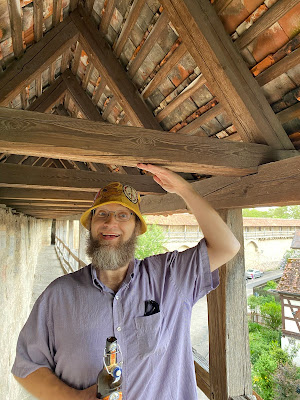 |
| This one actually had some inches to spare! There were several beams that Matt had to actually duck under, though, especially on the town-side of the wall. |
Before long, our hunger caught up with us, so we followed our noses to the Taj Mahal restaurant. For real. We could smell the redolent spices from well up the street. It is a small place and pretty busy for the dinner hour. The waiter set us up with another couple at a large table where there was room for all of us. The menu was extensive and it was difficult to choose. Everything was delicious, and the atmosphere was vibrant. I sampled my first "colaweizen," a bizarre but yummy combo of wheat beer and cola soda. This was something I had read about in my German research phase. As Matt says, I "live the beverage life," so of course I'd added colaweizen to the list of experiences I hoped to have in Europe. At the suggestion of the waiter, I also tried a wheat beer and Sprite combo called a Russ. It was good, too, sort of like a sweeter, bubblier shandy or radler.
 |
| We were impressed by the city walls in Oberwessel and Bacharach...but in Rothenburg we were absolutely blown away. The history, the beauty, the construction, the view! |
After dinner, we took another stroll through town...and ended up on the wall again. It was just so fascinating and offered such a unique view of the town. The buildings are colorful--mint, peach, yellow, ochre--and have these really cool striped shutters. We enjoyed the growing dusk from our elevated vantage...until it became too difficult to see the uneven stones underfoot, especially inside the towers. So, we made our way back to ground level. After meandering to the Market Square past illuminated fountains and stone gates, we made our way up the street to the Pension Elke.
 |
| Matt looking out of one of the arrowslits during an evening stroll on the city wall. |
Breakfast at the Pension Elke is served up in the attic area. We followed the narrow, steep stairs up to the narrow, steeply pitched room on the third floor. It was super cute. The attics are a common historical remnant in the houses in Rothenburg odt. At one point, every household was required to store a year's supply of food in case there was a siege of the town or other emergency. Pulleys on the exterior raised up the foodstuffs, which were stored in these attic rooms. A lot of the houses still have the pulleys and everything, even if the attics had been repurposed, as this one had been.
 |
| The attic "breakfast nook" at Pension Elke. |
We saw literally no one during our breakfast. The pension still had rooms for rent, in fact. It was clear we were ahead of tourist season proper. Of course, Matt and I had no complaints about that. Both Rick Steves and Eva, who writes the bilingual Untrodden Paths blog, had prepared us to rub elbows with A LOT of other tourists while in Rothenburg. Heck, Rick Steves basically equates it with a medieval theme park! His guidebook is sprinkled with advice for dodging the crowds. That was so far from our experience. Crowds? What crowds? Even when we did blatantly touristy things, like the Nightwatchman's Tour (more on that later), there weren't crowds. And ohhhhhhhhhhh we were delighted!
 |
| The St. George Fountain near the Market Square dates back to 1446. Fountains were an important part of the historic water system for the town. |
Don't get me wrong. I have come to accept that cool stuff attracts people who want to see that cool stuff. Matt and I were in Rothenburg ob der Tauber as tourists, too. It is like the crowds around Old Faithful in Yellowstone. I prefer to avoid them; they're not my favorite part of the geyser basin experience, but I get it. I understand that we have all come to share in something incredible...together. It comes with the territory in a world with 8 billion people. Still. Matt and I were pretty pleased to have arrived before the masses descended on the Disneyland of medieval Germany for the summer. Matt and I try to get our Yellowstone National Park fix in the spring, too, before the tourists arrive in bulk. Same thing.
 |
| Matt on the Rothenburg city wall. |
Immediately following breakfast, we set off to walk the entire city wall. We'd done a few sections on our first day, but since the wall is intact, you can walk the whole thing. Sometimes the path is inside the wall, sometimes outside the wall, and sometimes ON the wall. There are 20 interpretive plaques along the way. We wanted to do the full circuit and learn all about Rothenburg odt. Matt and I really dig interpretive signs. These were excellent--bilingual in German and English with maps and photos for orientation.
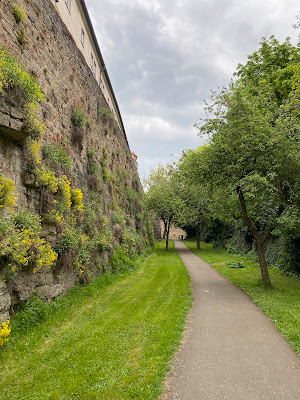 |
| Walking just outside the city wall offered a unique perspective on the fortifications, too. |
Our guidebook says, "Just longer than a mile and a half around...this walk can be done by those under six feet tall in less than an hour." Matt and I got a kick out of those descriptions for two reasons. One, Matt (at 6') did have to keep an eye out to avoid cracking his noggin. Two, walking the city wall took us allllllllllllllll day. To be fair, we kept getting distracted away from the wall, but we would go back and pick up the circuit where we left off.
 |
| Many of the houses still have doorbell pull cords at their entrance. I'd never seen that before. |
We had falafel, salad, and fries for lunch at Tobingo Döner. We saw our first White Stork and spent at least 15 minutes watching it on its nest. We took a stroll through the peaceful Convent Garden. We visited the St. Blasius Chapel inside the Castle Garden. The flowers and foliage in both gardens were lovely. The view of the town and the Tauber River valley from the Castle Garden was incredible. There were a bunch of elementary school children on a field trip. They were sprawled in the grass, sketching the city walls. I went on some cool fieldtrips...but Rothenburg odt seems like a really, really cool one. The Castle Garden is the site of the Hohenstaufen Castle--the Red Castle that gave Rothenburg its name--which was destroyed by an earthquake in 1356. Only the St Blaise Chapel was rebuilt and the rest was converted into a garden park. These days, the small chapel is a war memorial.
 |
| Forget-me-nots and tulips in the Castle Garden. I didn't know that forget-me-nots came in any other color than periwinkle blue. |
The most extensive, giant, mindblowing distraction was St. Jakobskirche (which in English is called St. James Church). It was built over 150 years and finally consecrated in 1485. This was originally a Catholic church, but has been Lutheran since 1544. The church structure itself is glorious. The colorful stained glass is made lovelier in conjunction with the clean, bright lines of the vaulted ceiling. Some of the stained glass is the originals from the 1330s!
 |
| Interior of St. Jakobskirche. I am standing near the High Altar, looking towards the rear of the church. |
But what truly left me astonished were a pair of woodcarved altars--the High Altar on the main floor and the Altar of the Holy Blood upstairs. I had no idea wood could be carved like that. The fine details, the layers and depth...for real. I had no idea.
 |
| The High Altar at St. Jakobskirche (front). The stained glass behind it is from the 1300s. The windows are an astonishing 55 feet tall! |
The High Altar (also called the Twelve Messengers Altar or the Twelve Apostles Altar) was finished in 1466. In addition to being a masterpiece of woodcarving, this altar is richly painted, front and back. It is lavish with goldness. I think this might have been when I finally made the connection between The Arts and The Church in medieval life. Like...a lot of artists were, in a way, basically church employees.
The 35-foot-tall Altar of the Holy Blood is unpainted wood, but that doesn't make it any less ornate. The detail on the woodcarving truly left me astonished. The swirling, curly hair of the apostles, the twining vines, the drape of their garments...it was amazing to me that someone could make all that texture and detail out of wood. We gazed at it, circled it, took it in from up close and from a distance.
 |
| The Altar of the Holy Blood at St. Jakobskirche. |
In addition, the altar was built to contain a relic (enclosed in crystal) that is said to be a piece of the tablecloth from Jesus' Last Supper on which wine (considered the blood of Christ) was spilled, making a stain in the shape of a cross. The altar was carved out of linden wood, which is, apparently, a favorite wood of termites in addition to artists. The altar was highly freckled with termite holes. This made it no less beautiful. It took the artist, Tilman Riemenschneider, five years to finish this masterpiece from 1499-1504. I thought it was just breathtaking.
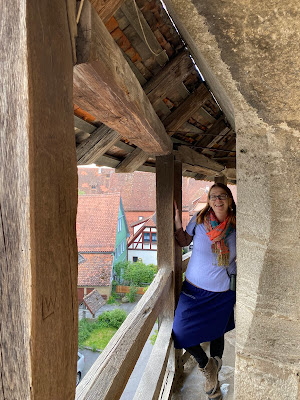 |
| This part of the walkway on the city wall was barely wider than my hips. |
After finally completing our circumnavigation of the city wall, we went to buy a thank you present for our friend Casey at a cute little shop we'd seen earlier. There we would have the most dramatic "it's a small world after all" moment of my life. But that's a whole separate post. Then we returned to our home base at Pension Elke. We picked up a bottle of regional wine from the grocery store before heading upstairs to our room for a nice, relaxing break before departing for the Nightwatchman's Tour.
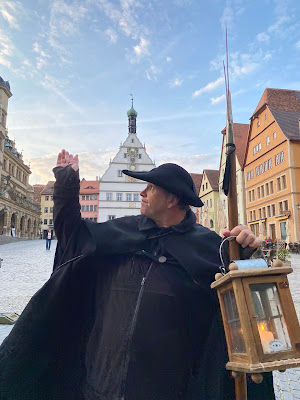 |
| The Nightwatchman starting his nightly tour through town. I was surprised he used a real candle in his lamp. I feel like it would be an LED candle in America. |
The nightwatchman was historically an overnight fire lookout. He'd wander around town while everyone else was asleep, keeping an eye out for fires and ready to sound the alarm. The modern-day version is like walking-theater-meets-history-lesson. To go on the tour, we just had to be in the Market Square at 8pm. The Nightwatchman turned up in his long black cloak with his halberd and lantern. We followed him through town (maybe 20 of us?) as he taught us the history--not all of it true, like the Mayor Nusch story--of Rothenburg odt through a series of stories, legends, and jokes. We learned about the church and the city hall, and heard the nightwatchman's rousing version of how their mayor once saved the town by drinking an obscene amount of beer. He showed us iron rods on the side of the City Hall that were the accepted units of measure used in Rothenburg prior to the widespread standardization of things like meters. He took us to see what he considers the best view of Rothenburg--from the Castle Gardens as the sun was setting. It was schticky humor, but I am a sucker for that so...it was perfect.
 |
| Approaching the Castle Gate after our nighttime walk in the Castle Gardens. |
Inspired by the Nightwatchman, we bought a falafel dinner to go and took it to the Castle Gardens for a romantic dinner outdoors. The trees and paths are illuminated with lights for a couple of hours in the evening. It was so quiet and peaceful. Crickets chirping and not another soul around. It is a beautiful garden during the day or the night. After finishing our meal, we made a loop of the garden and headed back to the room.
The next morning, we had another lovely breakfast at the Pension Elke and then set off for a stroll through town. Nowhere in particular, just following this charming street to that charming street. We inadvertently stumbled upon the Plönlein, an especially cute part of town that was used as the basis for buildings in old Disney cartoons--most notably, Pinocchio. We eventually put some intention behind our wandering so that we could take care of some important official business--finding a post office so we could buy stamps and mail postcards to folks back home.
With that accomplished, we went to the City Hall to climb the tower for a view over the town. The tower climb started with broad spiral stairs and then the stairs/stairwell kept getting smaller and more rustic, culminating in what was basically a short, wooden ladder at the very top. 220 steps in total. We popped out of a metal hatch and blamo! We were up on the top of the tower, almost 200 feet above Market Square. It was windy and beautiful. There was one other person up there, but he went back down shortly. We were free to move around the dome of the tower, taking in the view in every direction.
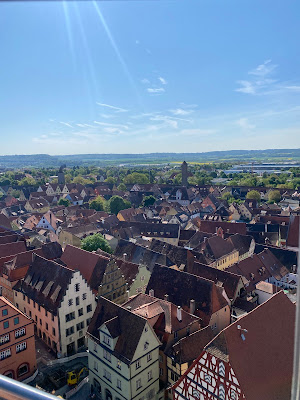 |
| A view of Rothenburg odt from up the Town Hall Tower. Note the yellow fields in the background. |
I don't always do well with heights, so I was equal parts terrified and delighted. Matt was just 100% delighted. The view of Rothenburg was fabulous, even if I did have to hold on to the railing with both hands to enjoy it. The railing had large gold spheres mounted on it. The spheres were basically the size of my head from up close, though they looked pretty small from the ground (as can be seen in the previous photo of the Town Hall). From this extreme vantage point, we could really see the red roofs, the enclosing city wall, the almost organic, "higgledy-piggledy" way the streets and houses spread and merge. I was ready to go back down, but Matt said if we waited a few more minutes, we could hear the 10am church bells chime from up there. So we did and that was a cool cherry on top of the tower experience.
 |
| Matt in the spiral staircase in the Town Hall. |
We went back to the room to put together a daypack. We stopped at the bakery and bought these amazing breadstick twists in a variety of flavors. My favorite was the black pepper. Properly equipped, we set off for the village of Detwang less than a mile away. We departed Rothenburg from the Castle Garden and followed an easy, downhill path to the Tauber River.
 |
| The forest trail to Detwang. |
Our path ran parallel to the Tauber the whole way to Detwang. We saw lots of birds, including a Grey Heron with a fish and a pair of Great Spotted Woodpeckers. The river was clear and lazy. It was so clear that we could see countless fish swimming about. Like, it was full of fish. We crossed a meadow that was carpeted with yellow buttercups. There was a covered wooden footbridge over the river. The trees were bright green and the shade was lovely. We thoroughly enjoyed the walk.
 |
| The Tauber River. |
Detwang was founded in 968 CE. As we entered town, we were immediately drawn to the church in the center. Since it wasn't noon yet, St. Peter and St. Paul's Church wasn't open for visitors. Matt and I walked through the small cemetery and then onward through the village. We really enjoyed seeing all the gardens. Pollinator houses were ubiquitous. It makes me want to make one for our garden. It's such a simple, good idea. One garden had an aviary full of parakeets and fancy pigeons!
 |
| St. Peter and St. Paul's Church in Detwang. |
We sat by a fountain near Detwang's maypole. We popped into the Hotel Schwarzes Lamm (Hotel Black Lamb) and ordered a couple of pilsners, which we enjoyed on the patio out front. It was incredibly sunny. Matt wrote some postcards. I did some drawing--a colorful rendition of the nesting White Stork we'd seen the previous day. We could hear sheep baaaaaing and lambs bleating from the rolling green hills around the village.
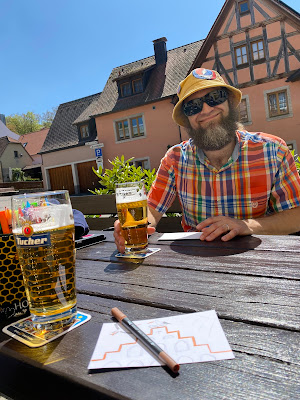 |
| Drawing and doing our correspondence on the patio at the Hotel Schwarzes Lamm in Detwang. |
Around 2pm, we meandered back over to the church. St. Peter and St. Paul's Church was small compared to most of the churches we'd visit in Europe. Matt said it reminded him of his parents' little Lutheran church in Montana. It was homey and humble in contrast to, say, the Cologne Dom. The interior was painted in subdued, earthy tones. St. Peter and St. Paul's Church is home to another woodcarved altar by Tilman Riemenschneider. Matching the nature of the church, this altar--the Altarpiece of the Holy Cross--is considerably more modest in size than the Altar of the Holy Blood up the hill in Rothenburg. It is equal, however, in the exquisite detail of the woodwork. There were a few other carved and/or painted altars in the church, including an altar to the Virgin Mary and a remarkable silver cross that was a gift when the church was consecrated in 1000 CE. It was a really peaceful country church.
We took a slightly different route back from Detwang. We saw a Roe Deer grazing in a meadow along the treeline. Even though the return trip was primarily uphill, we still enjoyed it immensely. We stopped to take in the Franciscan Church (Franziskanerkirche). This is the oldest church in town--built in 1285. There were a few small woodcarved altars--including another from the renowned Tilman Riemenschneider-- and some really unusual stained glass. Matt and I both thought it was broken at first glance.
 |
| A colorful street in Rothenburg ob der Tauber. The Town Hall tower we climbed is in the background. |
It was well into the afternoon, and our breadstick snacks had long worn off, so we went back to the ol' quick-and-reliable kebap shop for lunch. Afterwards, we went to the Bookstore Rupperecht, where I picked up a few deutsche kinderbücher (German children's books), including Der Struwwelpeter. This is a German "classic" and I'd tried to read a copy obtained through interlibrary loan. I powered through one very intense story about not playing with matches. That copy had been published in the fraktur font though... and that is just too much for me. I barely understand German when I am easily able to tell the difference between the Ms and Ws. I don't need another obstacle. To my delight, Bookstore Rupperecht had a version of Der Struwwelpete printed in a modern font! I also bought the German translation of A Very Hungry Caterpillar (Die kleine Raupe Nimmersatt).
 |
| Walking the cobblestones in Rothenburg. |
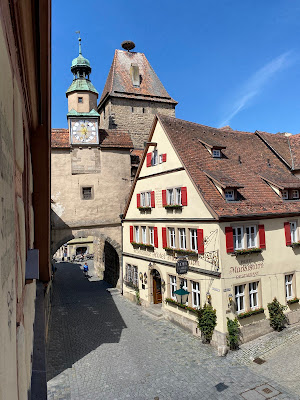 |
| This is the view of the street from the windows in our room. The stork nest on the tallest roof. |
I gave Matt a reading of Die Kleine Raupe Nimmersatt as we finished our wine. Then we set out for one final walk along the city wall. The sun was setting and the light was glorious. The church spires were backlit with a warm orange glow. The charming half-timbered houses with their red tile roofs were like something out of a film set. Matt and I talked as we walked, both of us feeling very content and happy. The vacation was going so perfectly. Everything seemed like a dream. As we wrapped up in Rothenburg odt, we were about halfway through the adventure. The first half was so freaking great. As we returned to the room to call it a night, we were excited to see what magic and beauty would come next.
 |
| Our last sunset in Rothenburg ob der Tauber. |
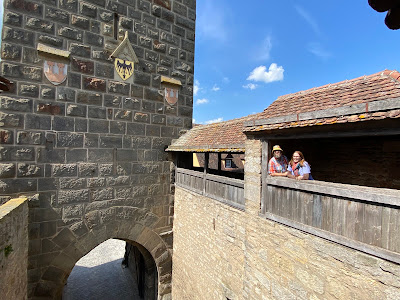








I'm very much enjoying coming along on your travel adventure.
ReplyDeleteHi Beth,
ReplyDelete...just catching up as I have set up my reader to use my 'incognito' account...so I'll be able to post comments again...hopefully...I loved coming along on your megavacation...
~Have a lovely day!